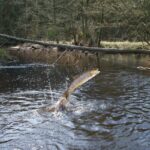The Muskellunge (Esox Masquinongy), or their more common name of muskie, is a predator fish that lives in the freshwater rivers and lakes of North America. Muskie teeth make it extremely difficult to catch them, and they can also be dangerous.
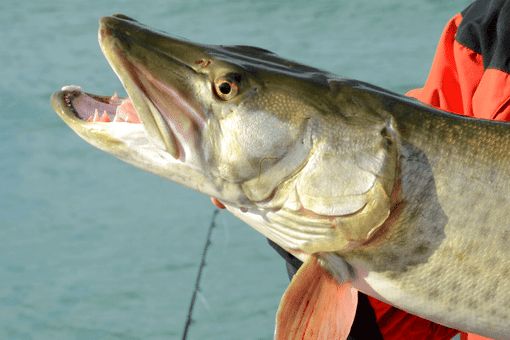
Muskies get their name from North American tribes like the Ojibwe, who called them maashkinoozhe, meaning great fish. They are the largest fish of the Escoidae (pike) family. Muskies are ambush predators that eat other fish (and sometimes smaller muskies), and humans and birds of prey are their only threats.
Properties of muskie:
- 28-48 inches in Length
- 15-36 pounds in Weight
The four muskie subspecies are:
- Spotted muskie
- Fish-barred muskie
- Clear muskie
- Tiger muskie
Fun facts about muskie:
- Official state fish of Wisconsin
- Muskies are nicknamed the “fish of a thousand casts” because of the difficulty of catching them
- Female fish can lay anywhere from 20,000 to 200,000 eggs a year
How Many Teeth Does Muskie Have?
A normal muskie can have an average of 500 teeth. However, older adult muskies can have up to 700 teeth. Muskies have two types of teeth: big canines and smaller needle-like ones. Both have razor-sharp edges that allow them to shred anything they come in contact with.
How Big Are Muskie Teeth?
Muskies have canines that can be up to one inch in length. The canines are in the muskie’s jaw and are used primarily for hunting. These muskie teeth grab hold of their prey and bring it inside their mouth.
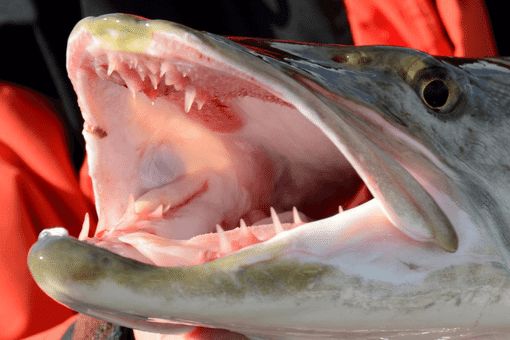
The rest of the muskie’s teeth are smaller and needle-like, ranging from 1/8 to 1/16 of an inch in length. These smaller needle-like teeth are angled inwards and are found on the roof of its mouth and its tongue, which prevents fish from being able to escape once it is in the muskie’s mouth. These teeth also flip a fish around so they can eat the fish headfirst.
Can Muskie Hurt Humans?
Yes, muskies can hurt humans either through improper handling or if they attack.
Muskie’s teeth are much sharper than other fish in their family. These teeth can shred the skin on your hand or leave lots of minor cuts, so you must be careful when trying to remove a lure from the muskie’s mouth. In addition, the muskie’s gill plates are scaled and very sharp and can cut your hands.
The occasional attack on swimmers or fishers who stick their hand in the water is rare but happens, so you should play it safe, regardless. Attacks happen if a muskie feels its environment is threatened, is distressed, or mistakes a body part for food.
What Is the Bite Force of Muskie Fish?
Muskies are said to have a bite force of 1200 PSI. To put this into perspective, this is the same bite force of a polar! As a result, muskies can bite deep into other fish for feeding purposes. Unfortunately, it also means that muskies can bite through your fishing line and hands, so you must be careful!
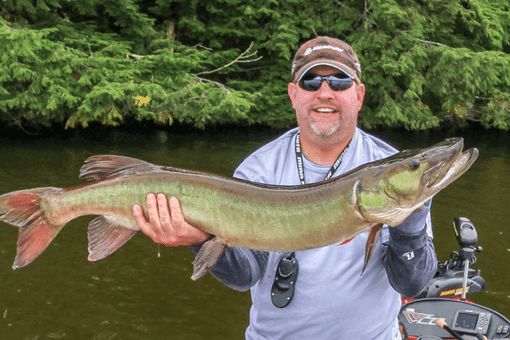
How To Handle a Muskie
Muskies are some of the most dangerous fish to handle, so you must have the proper tools and handle them carefully.
Here are the tools you will need to handle a muskie:
- Armored gloves
- Long-nose pliers
- Bolt/wire cutters
- Fishing net
We recommend using a jaw spreader when the hook is set deep in the muskie’s mouth to prevent accidental injuries to yourself or the muskie when unhooking a lure. Otherwise, it is not recommended to use a jaw spreader, as you can damage the muskie.
Either way, here is the proper procedure when unhooking a lure from a muskie’s mouth:
- Put the muskie in your net.
- Cut the main or leader line depending on how you caught the muskie.
- Slide the fingers of your other hand inside the muskie’s gill plate (be careful, as their gill plates can still cut you).
- Rest your thumb on the groove of the muskie’s jaw.
- Cut or remove the hook depending on its location.
- Release the fish by resting one hand on the muskie’s stomach in front of its first anal fins. You know you can let go of the muskie when it splashes its tail.
Can Muskie Bite Through Fishing Line?
Yes, a muskie can bite through a fishing line because of its razor-sharp teeth and bite force. However, using a standard mono fishing line by itself will probably end with you losing a line, lure, or the muskie itself.
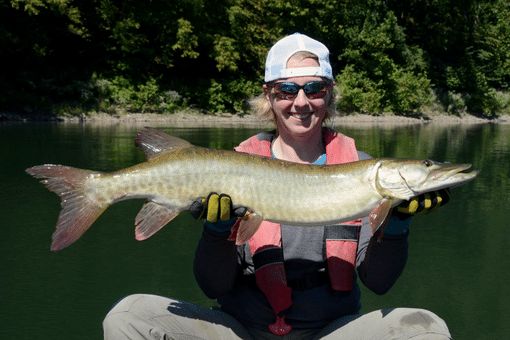
Professional anglers recommend using a leader line to prevent the muskie from biting through your main fishing line. A leader is a line you tie to the end of your main line in your fishing rod spool. A leader line doesn’t have to be the same type of line as your main line and can vary depending on where you are fishing and the species you are looking to catch.
Muskie recommended leaders:
- Use a heavy wire leader of 10 inches with a line testing of 170 to 220 pounds when fishing for muskie using dive and rise or jerk baits.
- Use a fluorocarbon leader of 12 inches with a 130 to 140-pound test when using trolling or larger lures to fish for muskie.
Monofilament Line
Pros of monofilament line:
- High knot strength
- Lots of knot variations
- Low visibility
- Decent abrasion resistance
- Floats
- Low price
Cons of monofilament line:
- Absorbs water
- Stretches
- Low UV light resistance
A Monofilament line is a fishing line that comprises a single fiber like nylon and is close to the density of water. This line is thin and less resistant to abrasion, so a leader will protect it against the muskie’s toothy bite. It is shiny and can spook fish as they can see it. It is good to use with topwater lures only.
A wire leader is recommended for monofilament lines as it provides extra strength against the muskie teeth.
Braided Line
Pros of braided line:
- Low stretch
- Low diameter profile
- Floats
- UV light resistant
Cons of braided line:
- Bad abrasion resistance
- Knot type limited
- Prone to tangling
- Expensive
Microfilament, or braided line, comprises braided strands of fibers like polyethylene. Muskies can bite through a braided line with tiny teeth, so you must use a leader. However, we do not recommend using a braided fishing line, as it is prone to tangling, which can hurt the fish.
Fluorocarbon Line
Pros of fluorocarbon line:
- Abrasion resistant
- Low visibility
- Denser than water (will sink)
- UV light resistant
- Knot strength
Cons of fluorocarbon line:
- Stiff
- Expensive
- High memory
A fluorocarbon line is also made of a single fiber like polyvinylidene fluoride, offering more abrasion resistance. It is nearly invisible, so it is good to use fish that spook easily. We recommend you use a 150-200 pound test fluorocarbon line if you do not use a leader to prevent a musky from snapping your line.
A thicker leader, at least .80 to 1.0 millimeters in diameter, is also recommended, as most muskies won’t be able to bite through this thick of a leader.
You can use a fluorocarbon leader for fishing with trolling or larger lures, as it prevents the teeth of the muskie from getting to your line. It is also nearly invisible, which gives you an advantage over another type of leader, like a wire leader.
- Do You Need An Indicator For Nymph Fishing? - November 16, 2023
- Fishing Safety Tips For Families - September 25, 2023
- What Is The Best Time To Night Fish At A Lake? - September 18, 2023


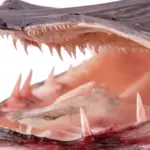

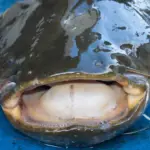
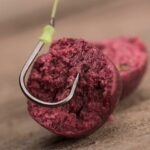
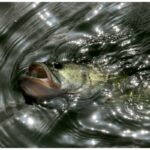
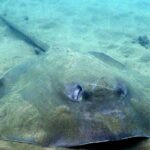
![Can You Eat Northern Pike? [Are They Good?] can you eat northern pike](https://irvinelake.net/wp-content/uploads/2022/09/can-you-eat-northern-pike-1-150x150.png)
